Just wondering- for those of you who inspect power lines, what are you looking for? How close do you get? Do you take photos or video?
thanks!
thanks!
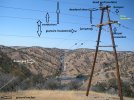 While a company may want only a few items looked at, typically as company workers we inspect the entire structure when on site. Down guys and structures are often hit by cars or tractors and lately over the last few years, cranksters steal copper grounding wire. The most important issues on typical transmission lines are insulator, line and jumper connection integrity. Sometimes you can pick a specific item to look over such as line spacers or dampers only. Once documented the company will generate a repair order depending how critical the problem is. The closeup below is of a 12kV distribution line & shows a split out cross arm.
While a company may want only a few items looked at, typically as company workers we inspect the entire structure when on site. Down guys and structures are often hit by cars or tractors and lately over the last few years, cranksters steal copper grounding wire. The most important issues on typical transmission lines are insulator, line and jumper connection integrity. Sometimes you can pick a specific item to look over such as line spacers or dampers only. Once documented the company will generate a repair order depending how critical the problem is. The closeup below is of a 12kV distribution line & shows a split out cross arm.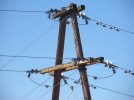
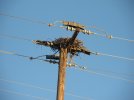
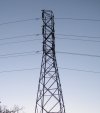
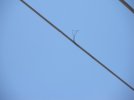
Have you been inspecting the PG&E Lines?When you inspect distribution & transmission lines you look for a variety of targets. Off the top of my head:
GO-95 infractions including vegetation management.
Overall structure integrity.
Chipped and or dirty insulators.
Insulators that have tracked. FLIR cameras can help. Sunlight can cause integrity issues with poly type insulators.
Broken or damaged strands on the conductor.
Any issues with the separators on multi conductor phases. Many come loose due to vibration.
Loose or missing Vibration damper's.
Missing/loose bolts/nuts and missing cotter keys on the shoes and any bolts that require cotter keys.
Stress cracks on the structure or equipment especially on dead end or suspension shoes and shackles.
Down guys and preforms.
Rust issues on any of the structure or equipment.
Bird problems. Nests can be an issue. Also when they crap on stuff it can cause corrosion on some metals and even problems leading to insulator breakdown.
Anchors must be looked over and any surface grounding needs to be inspected.
On wood structures you need to check the bonding if used. Also most companies test the woods integrity on a regular basis. This is often done on its own and may involve drilling/plugging core samples taken. Some do sound testing.
Jumper connectors should be closely inspected using a FLIR camera for abnormal heat and visually for missing bolts.
Poor construction practices...yes we screw up from time to time when building lines.
I've never had the luxury of a drone for basic inspections and used binoculars/spotting scopes and a handheld FLIR camera. If necessary I go up in my bucket truck. Line voltage determines how close you get. Each company should have required safety clearances to follow. My company doesn't require images by our own workers unless we find a problem. My guess a contractor doing inspections must show documented images of their inspections. But even in my patrols each structure is documented and a check list filled out. Each structure is numbered on a map. View attachment 124519While a company may want only a few items looked at, typically as company workers we inspect the entire structure when on site. Down guys and structures are often hit by cars or tractors and lately over the last few years, cranksters steal copper grounding wire. The most important issues on typical transmission lines are insulator, line and jumper connection integrity. Sometimes you can pick a specific item to look over such as line spacers or dampers only. Once documented the company will generate a repair order depending how critical the problem is. The closeup below is of a 12kV distribution line & shows a split out cross arm.View attachment 124512
View attachment 124513
View attachment 124514View attachment 124515
Typical gunshot conductor image.
Our company has just started using drones for difficult to reach areas. In the past we have also contracted helicopter inspections. Very expensive. I don't know what level of qualification is required for someone who isn't classified to actually work on energized lines. I'm required to run out and visually inspect all the Transmission lines in my patrol area twice a year. It might differ from state to state. Hope this helps.
Not really. Our company is a public utility and the only time I've dealt with PG&E (or other utilities) is with mutual power ties. I have friends who have asked me if I wanted to do ground based inspections for PG&E as side work but I get enough OT with my job. As mentioned I don't have a clue what other companies require as far as contractor experience or certification. Being I'm qualified to build and maintain power lines, I know what to look for and my company knows that. For drone inspections my guess is the power company might want images of specific equipment at certain angles for someone else who is qualified to look at the images after the drone flight has been completed. Even though I use a high dollar FLIR camera for a variety of things, actual drone inspection companies probably have a few more tip and tricks that I don't have any experience with.Have you been inspecting the PG&E Lines?
Thank you for your informative reply.Not really. Our company is a public utility and the only time I've dealt with PG&E (or other utilities) is with mutual power ties. I have friends who have asked me if I wanted to do ground based inspections for PG&E as side work but I get enough OT with my job. As mentioned I don't have a clue what other companies require as far as contractor experience or certification. Being I'm qualified to build and maintain power lines, I know what to look for and my company knows that. For drone inspections my guess is the power company might want images of specific equipment at certain angles for someone else who is qualified to look at the images after the drone flight has been completed. Even though I use a high dollar FLIR camera for a variety of things, actual drone inspection companies probably have a few more tip and tricks that I don't have any experience with.
What a fantastic reply! Thanks for posting. ????When you inspect distribution & transmission lines you look for a variety of targets. Off the top of my head:
GO-95 infractions including vegetation management.
Overall structure integrity.
Chipped and or dirty insulators.
Insulators that have tracked. FLIR cameras can help. Sunlight can cause integrity issues with poly type insulators.
Broken or damaged strands on the conductor.
Any issues with the separators on multi conductor phases. Many come loose due to vibration.
Loose or missing Vibration damper's.
Missing/loose bolts/nuts and missing cotter keys on the shoes and any bolts that require cotter keys.
Stress cracks on the structure or equipment especially on dead end or suspension shoes and shackles.
Down guys and preforms.
Rust issues on any of the structure or equipment.
Bird problems. Nests can be an issue. Also when they crap on stuff it can cause corrosion on some metals and even problems leading to insulator breakdown.
Anchors must be looked over and any surface grounding needs to be inspected.
On wood structures you need to check the bonding if used. Also most companies test the woods integrity on a regular basis. This is often done on its own and may involve drilling/plugging core samples taken. Some do sound testing.
Jumper connectors should be closely inspected using a FLIR camera for abnormal heat and visually for missing bolts.
Poor construction practices...yes we screw up from time to time when building lines.
I've never had the luxury of a drone for basic inspections and used binoculars/spotting scopes and a handheld FLIR camera. If necessary I go up in my bucket truck. Line voltage determines how close you get. Each company should have required safety clearances to follow. My company doesn't require images by our own workers unless we find a problem. My guess a contractor doing inspections must show documented images of their inspections. But even in my patrols each structure is documented and a check list filled out. Each structure is numbered on a map. View attachment 124519While a company may want only a few items looked at, typically as company workers we inspect the entire structure when on site. Down guys and structures are often hit by cars or tractors and lately over the last few years, cranksters steal copper grounding wire. The most important issues on typical transmission lines are insulator, line and jumper connection integrity. Sometimes you can pick a specific item to look over such as line spacers or dampers only. Once documented the company will generate a repair order depending how critical the problem is. The closeup below is of a 12kV distribution line & shows a split out cross arm.View attachment 124512
View attachment 124513
View attachment 124514View attachment 124515
Typical gunshot conductor image.
Our company has just started using drones for difficult to reach areas. In the past we have also contracted helicopter inspections. Very expensive. I don't know what level of qualification is required for someone who isn't classified to actually work on energized lines. I'm required to run out and visually inspect all the Transmission lines in my patrol area twice a year. It might differ from state to state. Hope this helps.
Yeah Woodpeckers do make some big holes, and also pack acorns in the wood.Great answer !!! I can't think of anything to add.
We have lots of Osprey nests up here and Pilated woodpeckers make holes you can put your fist right though...I have also seen poles clawed almost clean through that look like something cut by the Predator from bears looking for ants too. View attachment 124681
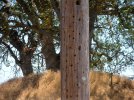
We use essential cookies to make this site work, and optional cookies to enhance your experience.

